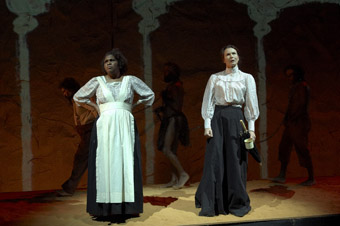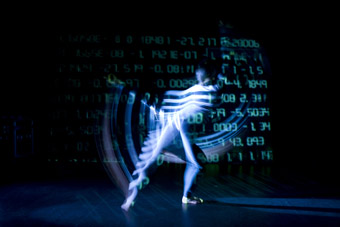reading the land, seeing the light
jonathan marshall at the 2008 perth festival

Ningali Lawford-Wolf, Margaret Mills, Kelton Pell, Tony Briggs, Jimi Bani, Jandamarra
photo Gary Marsh
Ningali Lawford-Wolf, Margaret Mills, Kelton Pell, Tony Briggs, Jimi Bani, Jandamarra
AFTER A ROCKY PREMIERE, JANDAMARRA BECAME A SUPERB WORK OF EPIC THEATRE, AKIN TO NEIL ARMFIELD’S CHEERY SOUL (1993) OR CLOUDSTREET (1998). DIRECTOR TOM GUTTERIDGE ECHOED ARMFIELD BY FILLING THE WINGS WITH PARTIALLY VISIBLE INSTRUMENTS, WIND-MAKERS, AND OTHER THEATRICAL MACHINERY WITH WHICH THE OFFSTAGE ACTORS VOICED THE ACTION. WITH ELDERLY INDIGENOUS SINGER GEORGE BROOKING SEATED BEFORE A MICROPHONE, THIS GAVE A SENSE OF MEMORY, BREATH AND RITUAL TO THE WORK, BRINGING THE ACTORS, FORMS AND HISTORIES TO LIFE.
Zoe Atkinson’s design for Jandamarra consisted of cliff panels—parting to reveal a vulva crease into which the protagonist stalked—bounded below by a sandpit from which set elements emerged or into which they were planted (fires, trees, graves). Platforms atop enabled split level performance, languid Indigenous scenes floating above tense European exchanges. Also remarkable was how Atkinson’s crinkled surfaces, projections of translations and Indigenous animations turned the space into a worn chapbook onto which histories and dreams were screened.
Jandamarra tells the story of the eponymous Aboriginal resistance leader in the Kimberley region in the 1870s, focusing on his complicated standing with whites and his own people. Never formally initiated into his clan, Jandamarra was befriended by the sporadically ruthless Constable Richardson before killing him and leading the Bunuba people against the graziers. The Bunuba attributed Jandamarra’s prowess to his magical skills, redefining him from tribal outcast to a key figure in their mythos.
Steve Hawke’s script was compiled with the traditional owners and Jandamarra’s story is portrayed in environmental terms above those of race or war. Jandamarra becomes one who, even without initiation, could read the land’s pain and recognise those waterholes which neither Bunuba nor white should disturb. Eventually, Jandamarra claims he fought not to defend his people per se, but the land itself. Although subplots involve black-white relations—notably the awkward reconciliation between the placeless station-owner’s widow and Jandamarra’s mother—the play comes across as somehow apolitical, being more about issues of the natural rather than racial oppression and armed resistance. It’s hard to imagine depicting the Irish resistance to English farming after 1600 in similar terms, despite the significance of Indigenous land use to both.
This recasting of identity in spiritual terms also characterised Tero Saarinen’s Borrowed Light. The Finnish choreographer drew on that American modernist archetype the Puritan sect, the Shakers. Together with the Amish, the Shakers’ austerity in their much collected furniture and quilts was central to 20th century American aesthetics, influencing architects (Frank Lloyd Wright’s furnishings), composers (Aaron Copland’s Appalachian Spring, written for Martha Graham) and dancers (Doris Humphrey, Twyla Tharp and Graham all produced Shaker pieces). The dialectic between Protestant restraint and the ecstatic seizures of devotees to such 19th century US ‘campfire meetings’ fascinated choreographers from Mary Wigman to Ruth Saint-Denis. Despite the hostility of these sects to modernism (the Amish do not drive) and social norms (the Shakers are celibate), they were central to post-WWII America’s self-definition as a streamlined, modern, yet lyrical, nation.
Saarinen sets aside these national references but embraces a nostalgia for disciplines of physical and emotional frugality and the tragedy of their loss. Borrowed Light is a hymn for a lost idea of what modern art was. Amidst the sustained simplicity of a choir (the Boston Camerata) singing Shaker hymns, Saarinen’s dancers twist and sway in unison (recalling Wigman’s “choric dancing”) before succumbing to individual contortions and an emptying out of the body via tension and release.
Bodies begin as trapezoids, with wide stompy legs (emphasised by the men’s black robes and the women’s dresses) rising to a dynamic torso. This alternates with expansion of the chest outward with arms not just flung back but curled into neurotic filigrees. Saarinen’s work is dramatically classical in its precision and sculptural form, yet its grotesque details recall butoh. The design also echoes Euro-American modernists, notably Adolphe Appia and Edward Gordon Craig, who advocated tides of directional white light between rising stairs to create a hierarchical space for the individual to strive for his or her spiritual ascent. Bounding the space, these flights and levels (differentially tinted black, grey and white by Mikki Kunttu) become a parable for the dancers’ terrestrial embodiment and their eternal striving, through and of the body, to free themselves. As dancers collapse and drag themselves across the space, the insufficiency of modernist ecstasy—as well as its joy—is performed.
A different sensibility is found in the work of Chrissie Parrott and Jonathan Mustard. Each piece in their trilogy, Metadance in Resonant Light, includes projection: animated figures in Recording Angel and Metadance, computer code in Metadance, and noirish Expressionism alongside the black-bobbed women of Split. Film noir is the dominant style in the latter, a duet supported by video showing dancers silhouetted in doorways. Head shots also feature, with hair swirling about visages, obscuring personalities even as they are suggested. Split evokes a house of memory and angst, affectively placing it in a predigital realm. This is further enhanced through haunting, aged-sounding music by Set Fire To The Flames. Split is animated by doppelgangers—the women’s other selves, and their struggle against their own otherness; femme fatales of their own desire. While similar to In Absentia (1997) by Sandra Parker and Margie Medlin—another work evoking uneasy memories through projection—Parrott’s work is more dramatic, with suggestions of specific (if opaque) characters.

Metadance
photo Jon Green
Metadance
Metadance has four dancers within a sea of floating and spinning text which codes music and avatars. As with Merce Cunningham’s Biped (1999), Parrott uses the X-Y-Z coordinates so generated to devise the choreography. Nevertheless, the movement remains recognisably hers. Hidden amongst translucent screens bearing rows of letters and grids, dancers under spotlights mark a constrained area with taught precision and line. Full limb extensions are common. Although each body often crouches low with one leg moving out at 30 degrees under the hips while the other bears the weight, aggressive twists or bends are rare. The dance retains Parrott’s sense of lyric control and clarity. Mustard’s music is less characteristic, departing from his 1980s MIDI palette to create a weft of ringing metallic strikes echoing away eternally, radiophonic quotations (a French vaudeville song for the juggling interlude, complete with projected balls), shuddering percussive fields and whining tones.
Recording Angel is the most impressive of the trilogy, simplifying and extending Metadance. Dancer Joshua Mu perches, birdlike, head down, arms spread, barely visible under tints of blue, posed beside his virtual double. The separation between live performer and avatar is blurred, both defined by slight glows within an ill-defined space. The measured choreography also imparts a sculptural feel, challenging not only distinctions between body and projection but dance and installation. It is often hard to see the movement. This is combined with Martin Tellinga’s music, recorded so well that, even in stereo, it sounds like its windy sheets and angry shimmering textures are charging behind us. Beyond narrative, meaning, or choreographic or dramaturgical evolution, Angel is a durational, experiential piece, affectively holding spectators in a profoundly sensual yet indeterminate fashion. As such, it avoids clichés of oscillating between technological visions of Frankensteinian disaster or naïvely utopian transcendence, to suggest a state neither liberating nor oppressive, yet intensely affective.
Perth International Arts Festival 2008: Black Swan Theatre Company with Bunuba Films, Jandamarra, writer Steve Hawke, director Tom Gutteridge, associate director, performer Ningali Lawford-Wolf, musical director Paul Kelly, designer Zoe Atkinson, lighting Andrew Lake, projected animations Kaylene Marr, Clancie Shorter, performers: Margaret Mills, Jimi Bani, Geoff Kelso, Emmanuel Brown, Tony Briggs, George Brooking, Simon Clarke, Peter Docker, Danny Marr, Kelton Pell, Dennis Simmons, Kevin Spratt, Sandra Umbagai-Clarke, Perth Convention Centre, February 9–23; Tero Saarinen Company and the Boston Camerata, Borrowed Light, choreographer, performer Tero Saarinen, musical director Joel Cohen, design & lighting Mikki Kunttu, costumes Erika Turunen, sound Heikki Iso-Ahola, His Majesty’s Theatre, Feb 27–Mar 1; Metadance In Resonant Light, choreography Chrissie Parrott, lighting/projection Jonathan Mustard, performers Joshua Mu, Sharlene Campbell, Sally Blatchford, Jacqui Claus. PICA, February 14–21
RealTime issue #84 April-May 2008 pg. 34






